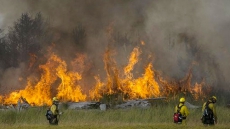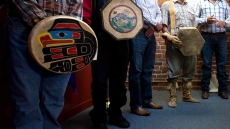CALGARY — Oil prices are the lowest they've been since the Great Recession and mayors in Alberta's oilpatch are noticing the difference.
"The barber says that he has less customers coming in," says Tom Tarpey, mayor of Peace River, population 7,000.
"I certainly notice less trucks and cars parked at the hotels in town overnight."
The town in northwestern Alberta is eager to see the economic boost from Shell's Carmon Creek oilsands project. But in May, the company decided to slow the development by two years while it looks for ways to drive down costs amid a pronounced slump in oil prices.
U.S. benchmark oil dropped below US$41 a barrel in Wednesday trading. The last time West Texas Intermediate crude languished in that range was early 2009.
"We don't anticipate the price of oil increasing in short order," said Tarpey. "We see a year to maybe two years before the price of oil recovers to the heady days of US$75-plus."
As a result, Peace River is looking to Alberta's NDP government for "economic stimulus" in the form of infrastructure projects, he said.
In Grande Prairie, a city of nearly 69,000 about a two-hour drive southwest, the impact is also being felt, said Mayor Bill Given.
But — as is the case in Peace River — the oil and gas industry isn't the only game in town. For instance, the forestry industry is buffering the impact of the oil downturn somewhat.
Grande Prairie's energy industry is also heavily focused on natural gas. Operators in the area have been dealing with low prices for that commodity for years and have learned to become more efficient, Given said.
"Yes, we're down. Are we down as far as other parts of the province? No, probably not. Would we like to be up a little bit higher? Yeah, sure, potentially. But overall, we're doing fairly well."
Omer Moghrabi, mayor of Lac la Biche, Alta., — about two and a half hours northeast of Edmonton and close to where the likes of Cenovus (TSX:CVE) and Canadian Natural Resources (TSX:CNQ) have major oilsands operations — figures his town has been through three or four busts over the past four decades.
"We thought it would start to rebound a little quicker," he said of this downturn.
Like many oil-centred regions in Alberta, Lac la Biche County has a sizable shadow population — transient residents who come for work, often living in camps or hotels. Its 2013 municipal census found this group made up about a quarter of the county's population of 12,000.

Moghrabi figures the shadow population has dropped to some degree, but it's not clear by how much. Companies that provide services to the oilpatch are feeling the pinch and retailers and restaurants in town are hurting, he said.
"But boy, the town still looks busy," said Moghrabi, who added that finding a parking spot it still a challenge. The oilpatch may be slowing, but tourists are still flocking to the area's lakes this summer, he said.
In Cold Lake, southeast of Lac la Biche, near the Alberta-Saskatchewan boundary, the downturn is noticeable, said Mayor Craig Copeland.
"You can see the difference in terms of traffic," he said.
Copeland said he's concerned work will dry up if the downturn stretches into 2016 and that tradespeople will up and leave — creating conditions for a labour crunch when crude prices do eventually rebound.
Housing affordability has been a challenge in the young and growing city with a population of nearly 16,000. So falling home prices and increased housing supply is actually a welcome development, said Copeland.
"The industry is slow out here. People are hunkering down and just watching the market."






